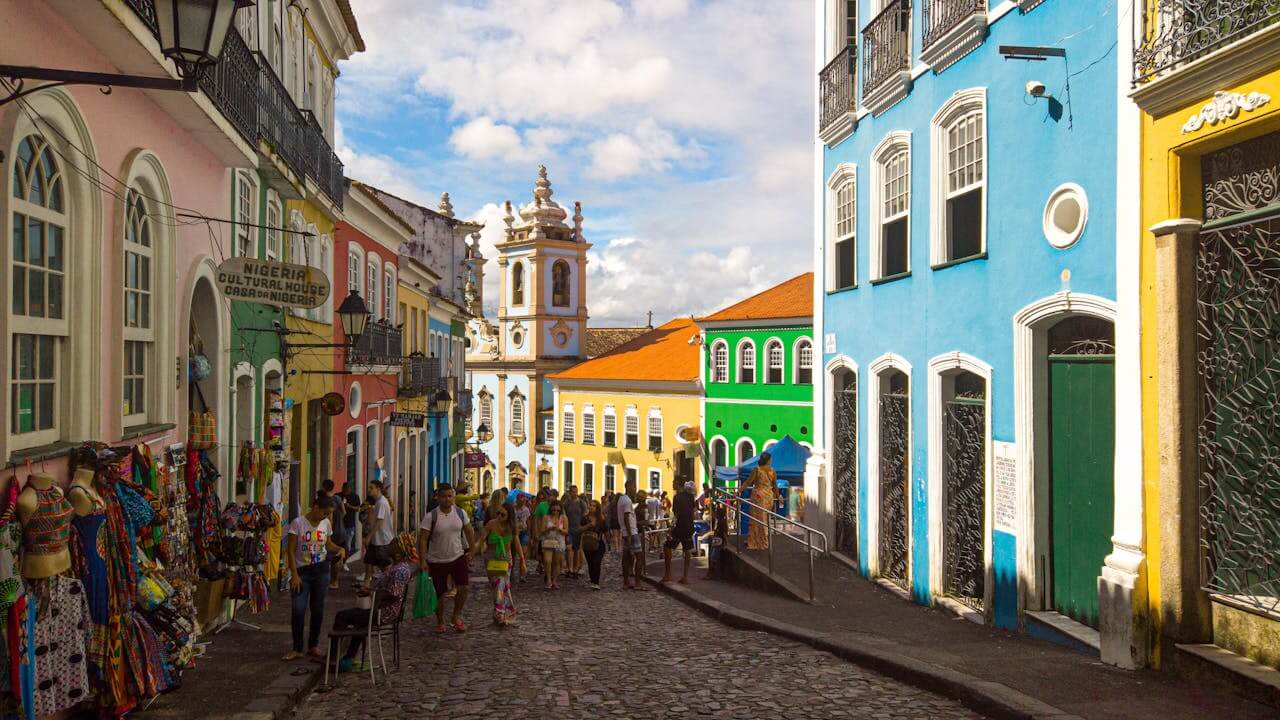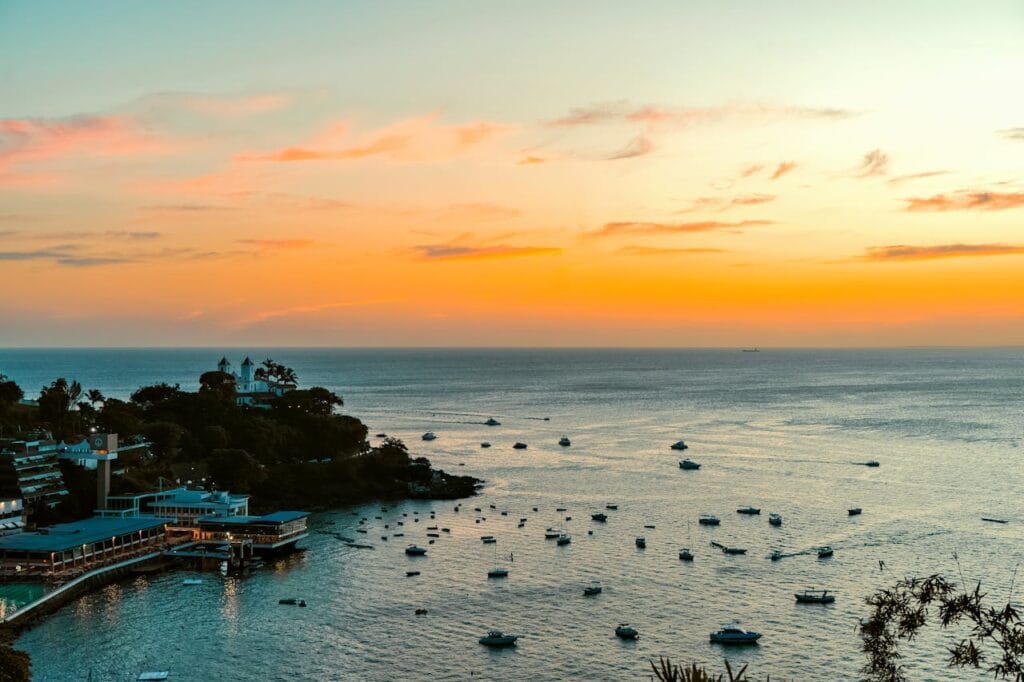
Disclosure: This post includes affiliate links. If you make a purchase through them, I may earn a small commission at no extra cost to you. This helps support the content I create.
Salvador is a city that has something for every kind of traveler. Want to relax on a beautiful beach? You’re in the right place. Prefer culture and history? There are museums, churches, and colonial buildings everywhere you go.
If you’re planning a trip and looking for the best things to do in Salvador Brazil, I’ve put together a list of my personal favorites — based on real experiences that I think are absolutely worth it.
You’ll find a mix of must-see attractions and more offbeat suggestions to help you make the most of your time in the city.
Check out this complete guide to Salvador, with tips on the best time to visit, how to get there, where to stay, what to do, and much more!

Pelourinho is one of the most famous places in Salvador — and truly a must-visit. Located in the heart of the Historic Center, this neighborhood is packed with colorful colonial houses, cobblestone streets, squares, museums, churches, artisan shops, and restaurants.
Recognized as a UNESCO World Heritage Site, Pelourinho isn’t just beautiful — it’s alive. You’ll hear drummers playing on the streets, see Capoeira performances in the plazas, and probably catch some live music echoing through the narrow alleys.
But there’s also a deeper, more painful side to its history. This was once the site of the pelourinho — the whipping post where enslaved Africans were publicly punished during Brazil’s colonial era.
From the 1500s until the abolition of slavery in 1888, this area witnessed countless acts of cruelty. It’s important to walk through here with respect for its cultural and historical significance.
I recommend setting aside at least a full day to explore the Pelourinho and surrounding Historic Center. There’s a lot to see, and most of it is only accessible on foot — many streets are pedestrian-only.
Wear comfortable shoes, bring water, and be ready to walk a lot.
⚠️ Safety Tip: As charming as Pelourinho is, it’s also a place where tourists need to stay alert. Pickpocketing, phone snatching, and small scams (like the “bracelet trick” or photos with Baianas) are not uncommon.
Avoid flashy clothes and accessories, keep your phone out of sight when not in use, and don’t walk around alone at night.
If you want more detailed safety tips, I’ve written a full post about staying safe in Salvador — you can check it out here.
Want to explore the area with a guide?
Honestly, I highly recommend it — especially if you’re traveling solo or visiting Salvador for the first time. Not only do you feel safer, but you also get to learn so much more about the culture and history behind each place.
👉 I suggest this Walking Tour Through Pelourinho — it’s one of the most highly rated tours and gives you a deeper understanding of the area.
For a more relaxed, in-depth look at Salvador, the City Highlights Private Tour lets you customize the route — choose among five itineraries covering both the Historic Center and Baía de Todos os Santos with hotel pickup included.
2. Visit Salvador’s Beaches
Let’s be honest — no trip to Salvador is complete without some beach time. With over 75 km of coastline, the city is truly a coastal paradise, and there’s a beach in Salvador for every mood.
If you’re staying near the city center, two of the most popular options are Porto da Barra and Farol da Barra. Porto is great for swimming, with calm, clear waters and a lively vibe — it’s usually packed with locals and tourists alike.
Just next door, Farol da Barra offers stunning sunset views and a great atmosphere for people-watching.
For a quieter beach day, I recommend heading to Praia de Ondina, Praia do Buracão, or Praia da Paciência. These are smaller, more local spots that are perfect if you’re looking to relax away from the big crowds.
Want to venture a little farther? It’s worth it. Stella Maris and Praia do Flamengo are two of the favorites — wide stretches of sand, strong waves, and a more laid-back vibe.
These are great for those who enjoy beach bars with good food and fewer crowds compared to the city center.
🏖️ Want the full list? I wrote a detailed guide with 11 amazing beaches in Salvador. You can check it out here.
Sign up Now for the Best Travel Tips exploring Brazil!
Get expert travel tips, detailed itineraries, and insider recommendations for
3. Watch the Sunset in Salvador
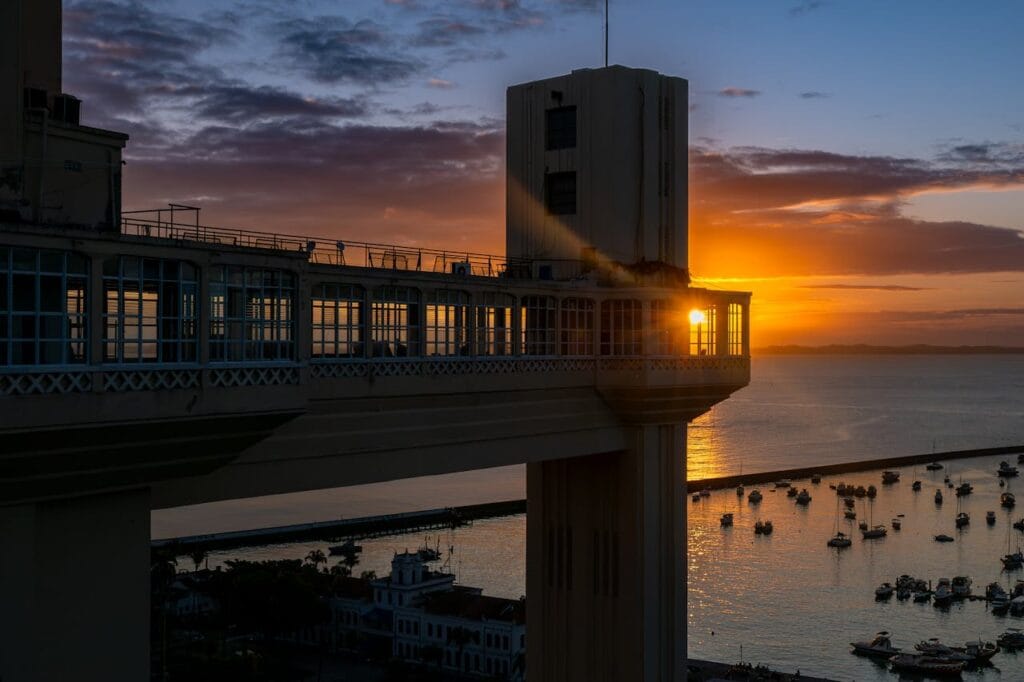
Sunset in Salvador isn’t just a time of day — it’s an experience. Trust me — the golden hour here is something else. Salvador is one of the rare places in Brazil where you can actually watch the sun set over the sea, and every day the show is a little different.
Some of the favorite spots to catch the sunset are:
- Ponta do Humaitá, a peaceful spot overlooking the Bay of All Saints;
- Farol da Barra, where locals and tourists gather at the lighthouse for stunning views;
- Morro do Cristo, right by the beach, with panoramic views of the coastline;
- Elevador Lacerda, one of Salvador’s most famous viewpoints;
- Solar do Unhão, where you can sip a drink and sometimes hear live jazz by the water;
- Praia da Ribeira, for a laid-back vibe, cold beer, and classic Bahian snacks;
- Porto da Barra, one of the only places in Brazil where the sun sets directly over the ocean;
- And even bars in Santo Antônio Além do Carmo, where a good drink comes with a golden view.
I recommend planning your days so you can watch the sunset from a different spot each evening — it’s one of the best things to do in Salvador Brazil and a moment you’ll definitely want to remember.
4. Visit Morro de São Paulo
Morro de São Paulo is a car-free island south of Salvador, part of Tinharé Island, and one of the best things to do in Salvador.
The most visited beaches are Segunda Praia (more active and social), Terceira Praia (good for swimming and boat trips), Quarta Praia (more quiet), and Garapuá, which is less developed and often overlooked.
If you have even more time, you can also plan a boat trip to Ilha de Boipeba, another island nearby with even fewer crowds.
However, if you only have one day, a full-day tour is a smart way to visit without losing too much time.
I recommend this Morro de São Paulo Paradise Island Daytrip — it picks you up from your hotel, covers ferry, van, and speedboat transfers, and includes around 6 hours on the island and offers time for beaches, strolling the village, and optional activities.
5. Visit the Farol da Barra and Forte de Santo Antônio

The Farol da Barra is one of the most recognized landmarks in Salvador. Installed in 1698, it was the first nautical signaling system to operate in the Americas — and it’s still active today, making it the oldest working lighthouse on the continent.
The lighthouse sits at the tip of the Barra neighborhood, right where the open waters of the Atlantic Ocean meet the calmer Bay of All Saints (Baía de Todos os Santos).
At the base of the lighthouse is the Forte de Santo Antônio da Barra, Brazil’s oldest military structure. Inside is the Museu Náutico da Bahia, which displays navigation instruments, maps, ship models, and items recovered from shipwrecks — some submerged for over 300 years.
After the tour, you can have a drink at the small bar next to the fort and enjoy the ocean breeze.
In the late afternoon, the area around Farol da Barra becomes a popular gathering place for locals and visitors. Many come to walk, sit along the shore, or watch the sunset.
6. Walk from Porto da Barra to Farol da Barra
One of the simplest and most pleasant things to do in Salvador is walking the short stretch between Porto da Barra and Farol da Barra. It’s just over 1 km along the coastline, and the path is flat, easy, and open to pedestrians.
Along the way, you’ll have a clear view of the Baía de Todos os Santos, and it’s a great spot to take photos, stop for a swim, or just sit and enjoy the breeze.
The route connects two of the city’s most visited spots, so it’s common to see locals jogging, swimming, or meeting friends by the sea.
This walk is especially worth doing at the end of the day, when the sun starts to set over the water.
📍 Staying around here makes everything easier — see the best areas to stay in Salvador if you want to base yourself near Barra.
7. Visit Ilha dos Frades and Ilha de Itaparica
A boat trip to Ilha dos Frades and Ilha de Itaparica is one of the most popular day trips from Salvador.
Ilha dos Frades stands out for its clean waters, peaceful atmosphere, and environmental conservation efforts.
Once on the island, you can explore different beaches, enjoy food at local restaurants, hike to the church of Nossa Senhora de Guadalupe, and relax in the quiet landscape. An environmental fee of R$ 25 is charged on arrival.
One standout is the Restaurante Preta, a well-known and beautiful restaurant — reservation is usually required. The setting is rustic and peaceful, and the menu changes often, with fresh seafood and regional ingredients.
Most tours include stops at more than one beach, but if you prefer a slower pace, it’s worth focusing just on Ilha dos Frades for the day. While it’s part of Salvador, there are no roads connecting it to the mainland — you’ll need to go by boat. The most common options are:
- Tourist schooners from Terminal Náutico (around 1h40 each way);
- Local boats from Madre de Deus (budget-friendly and used by locals);
- Private speedboats (flexible but more expensive).
Ilha de Itaparica, the largest maritime island in Brazil, is another destination you can explore. It’s bigger, with more infrastructure, and has both calm beaches like Cacha Pregos and Mar Grande, and historic areas to visit.
If you’re planning to stay overnight, Itaparica has more accommodation options than Ilha dos Frades.
You can get there by:
- Ferry boat from Terminal São Joaquim in Salvador to Bom Despacho (40–60 min);
- Fast boat from Terminal Náutico to Mar Grande (about 45 min);
- By car, via Ponte do Funil, connecting the island to the mainland through the BR-324 highway.
Depending on your travel style, you can visit both islands in one day or choose one to explore more calmly.
8. Take a Day Trip to Praia do Forte

Praia do Forte is located about 80 km north of Salvador, in the municipality of Mata de São João. It’s one of the most visited beach destinations near the city and can be reached by car, transfer, or group tour.
The village has a pedestrian-only center with restaurants, shops, and beach access. The sea is usually calm and warm, which makes it a good spot for swimming and walking along the shore.
One of the main attractions is Projeto Tamar, a sea turtle conservation center open to visitors. The visit is simple and informative, with tanks, educational displays, and rescued animals on site.
A day is enough to walk around, swim, have lunch, and explore the village.
If you’d rather not worry about logistics, this Praia do Forte private tour is a practical way to enjoy the highlights in a single day — with hotel pickup and a flexible schedule.
But if you have time, it’s worth spending at least one night. There are many places to stay, and the experience is more relaxed when you’re not in a rush.
9. Explore Salvador’s Museums
Salvador has several institutions dedicated to art, music, religion, and Afro-Brazilian heritage — and they help you better understand the cultural background of the city.
You can start at the Museu de Arte Moderna da Bahia (MAM), located at Solar do Unhão, right by the sea. It combines art exhibitions with a unique setting and often hosts events and live music.
Then, visit the Casa do Carnaval da Bahia and the Cidade da Música da Bahia, two interactive spaces that show how music is part of daily life in Salvador.
If you’re into literature, two museums are dedicated to Jorge Amado and Zélia Gattai, one of Brazil’s most famous literary couples.
Jorge Amado was a novelist from Bahia known for writing about Brazilian society, especially the people, culture, and contradictions of Salvador. His books have been translated into dozens of languages and turned into films, plays, and TV series.
At the Casa do Rio Vermelho, you can walk through the home where they lived. The rooms, furniture, books, photos, and letters remain in place, and the garden is where the couple’s ashes were buried.
The Fundação Casa de Jorge Amado, located in Pelourinho, focuses on preserving his work and legacy.
For maritime history, check out the Museu Náutico da Bahia, inside the Forte de Santo Antônio, and the Museu do Mar Aleixo Belov, focused on navigation and sea travel.
To learn more about Afro-Brazilian culture, visit the Casa do Benin and the MUNCAB – National Museum of Afro-Brazilian Culture. Both offer insight into the African roots of Salvador’s traditions and identity.
Other options include the Museu de Arte da Bahia, Museu Carlos Costa Pinto, and Museu de Arte Contemporânea da Bahia, each with collections ranging from fine art to historical artifacts and furniture.
10. Visit Salvador’s Churches
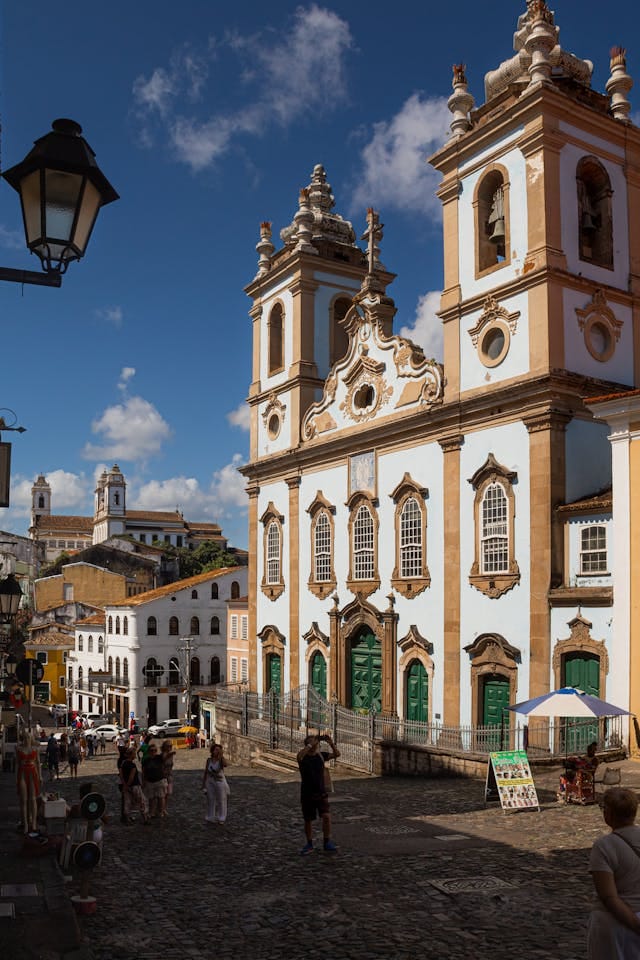
Salvador has over 360 Catholic churches spread across the city. Visiting at least a few of them is a way to understand more about its history and religious traditions.
One of the most visited is the Church and Convent of São Francisco, located in Pelourinho. It’s especially impressive — its interior is covered in gold leaf and considered one of the finest examples of baroque architecture in Brazil.
The Catedral Basílica de Salvador, built starting in 1657, is considered one of the most important Catholic church in Brazil. It has a sacred art museum and underground catacombs that are open to visitors.
Another important site is the Church of Nosso Senhor do Bonfim, known for its colorful ribbons and the traditional Lavagem do Bonfim procession. Visitors tie ribbons to the church gates and make wishes — a practice that became a symbol of Salvador.
In Pelourinho, the Church of Nossa Senhora do Rosário dos Pretos stands out. It was built by and for enslaved people in the 18th century and still holds masses with Afro-Brazilian influence.
Not all churches are famous, but many hold pieces of the city’s history. When walking around, take a moment to step inside — even the ones that aren’t in the guidebooks often have something to show.
11. Ride the Lacerda Elevator
The Lacerda Elevator is one of Salvador’s best-known landmarks — and also a key part of how the city works.
It connects the Upper City (Cidade Alta), where the Historic Center and Pelourinho are located, with the Lower City (Cidade Baixa), home to the Mercado Modelo and the port area.
Built in the 19th century and fully renovated in 1930, it was the first urban elevator in the world. Today, it’s still a functioning part of the public transport system and carries thousands of passengers every day.
The ride takes less than 20 seconds and costs just R$ 0.15. It’s simple, quick, and practical — especially for visitors moving between the historical and commercial parts of the city.
From the upper platform, you get a clear view of the Bay of All Saints, including the lower city and parts of the coastline. It’s one of the easiest spots to stop for a photo and a good way to understand Salvador’s geography.
12. Shop at Mercado Modelo and Feira de São Joaquim
If you’re looking to shop in Salvador, two markets stand out — Mercado Modelo and Feira de São Joaquim.
Mercado Modelo, located right by the bay in the Lower City, is one of Salvador’s most visited tourist spots. It used to be the city’s main supply market, but today it functions mainly as a shopping space for local products and souvenirs.
Inside, there are over 250 stalls selling lace clothing, wood carvings, jewelry, musical instruments, leather goods, and traditional Bahian food items. You can also grab a snack or drink at one of the restaurants.
It’s a convenient stop if you’re looking for affordable souvenirs. But if you’re looking for something different or higher quality, you will find better pieces in the shops around Pelourinho.
For a more local experience, I recommend visiting the Feira de São Joaquim. It’s the largest open market in Salvador and used mostly by locals.
You’ll find fresh produce, religious items, handmade goods, and everything in between. The market is not designed for tourists, so the experience can feel intense — crowded, noisy, and at times, smelly.
Both markets show different sides of Salvador. Mercado Modelo is more organized and tourist-friendly, while Feira de São Joaquim gives you a look at the city’s daily life.
13. Try Bahian Cuisine

Eating well is part of the experience in Salvador. The city has a strong food culture shaped by African, Indigenous, and Portuguese influences.
If you enjoy trying new flavors, tasting Bahian food is one of the best things to do in Salvador Brazil.
Start with some of the most traditional dishes. Acarajé is a must — a black-eyed pea fritter fried in dendê oil and filled with vatapá, caruru, and shrimp.
You’ll find it at street stalls all over the city, especially from vendors like Cira, Dinha, and Regina.
Another classic is moqueca, a seafood stew cooked with coconut milk, herbs, and spices. For sit-down meals with regional flavors, check out restaurants like Casa de Tereza and Dona Mariquita.
If you’re looking for something more contemporary, Salvador also has restaurants that bring together Bahian cuisine and modern techniques. Good options include Amado, Mistura Contorno, and Poró.
Don’t forget dessert. Try cocada (made from coconut and sugar) or visit ice cream shops like Sorveteria da Ribeira and Sorveteria Cubana — both are well known for their variety of tropical flavors.
You can also explore local drinks. Popular choices include caipirinha, fresh sugarcane juice (caldo de cana), and a wide range of fruit juices made with ingredients like graviola, caju, umbu, acerola, and cupuaçu.
If you’re around Pelourinho, stop for a coconut-lemon juice from Mr. Milton, and try the cachaça from Cravinho Bar.
🍽️ Want more food recommendations? I wrote a full post about the best restaurants in Salvador — from casual spots to special-occasion places.
14. Attend Carnival
If you’re in Salvador between late February and early March, Carnival is hard to ignore — and for many, it’s one of the best things to do in Salvador Brazil.
Salvador’s Carnival is not just a party. It’s one of the largest street festivals in the world and recognized as one of the biggest participatory celebration on the planet.
Over the course of 14 days — including warm-up events — millions of people take over the streets in different parts of the city, following trio elétrico trucks, dancing to axé music, and joining different blocks and cultural groups.
That said, Carnival is not for everyone. It’s crowded, loud, and prices go up during the holiday.
If you’re not visiting during the main event, you can still experience the Carnival atmosphere — from December to March, Salvador hosts a full schedule of open-air rehearsals and lively parties, both free and private, in different parts of the city. To check dates and locations, look up the ‘Calendário de Verão de Salvador‘ (Salvador Summer Calendar).
15. Walk Along Salvador’s Beachfront
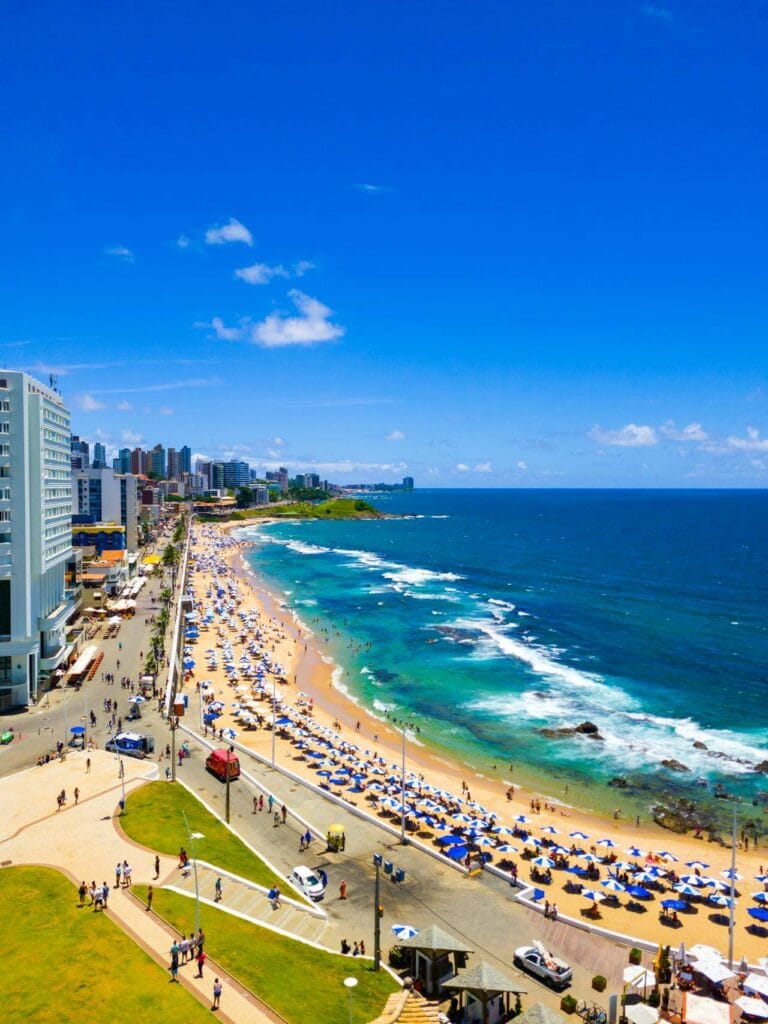
One of the easiest and most pleasant ways to enjoy Salvador — and one of my personal favorites — is simply walking along its beachfront (orla).
The city has a long coastline, and several stretches are perfect for walking, running, cycling, or just sitting and watching the sea.
The Barra–Ondina promenade is one of the most popular areas. The path is wide, well-maintained, and full of movement — especially in the late afternoon.
You’ll pass by important spots like Farol da Barra, Morro do Cristo, and Praia de Ondina, all with views of the sea and easy access to snacks, drinks, and places to rest.
Another good area is the orla do Rio Vermelho, which connects beaches like Praia do Buracão and Praia da Paciência. It’s a shorter walk, but the vibe is more local, and there are many bars and cafés along the way.
Further north, areas like Itapuã and Stella Maris also have walkable beachfronts with wide sand strips, natural pools during low tide, and kiosks where you can try grilled fish, coconut water, or cold beer.
16. Walk Around Santo Antônio Além do Carmo
Santo Antônio Além do Carmo is a quieter part of Salvador’s Historic Center, just next to Pelourinho. It has fewer tourists, but just as much charm. The streets are lined with old colonial houses, local businesses, and small churches.
You can start your walk at the top of Pelourinho and head toward Largo do Carmo, where you’ll find a good view of the Baía de Todos os Santos. Along the way, it’s worth taking your time — the streets are peaceful, and the area has a more local feel.
This is also one of the favorite places to have a beer in the late afternoon. Many bars and restaurants have balconies facing the bay, which makes it a great spot to watch the sunset.
A few places I recommend are Bar Cruz do Paschoal, Poró Restaurante & Bar, and Raiz Restaurante.
17. Watch a Football Match
Football is serious business in Salvador. If you’re a fan of the sport, watching a match at Arena Fonte Nova can be a highlight of your trip. The city’s two main teams — Bahia and Vitória — have one of the most intense rivalries in Brazil, known as the Ba-Vi.
If there’s a Ba-Vi happening while you’re in town, try to get tickets — the energy in the stadium is unlike anything else. Even regular matches are worth it if you enjoy experiencing how locals live their passion.
If football isn’t your thing, check the event schedule at Arena Fonte Nova — it also hosts concerts and cultural events. The stadium is modern and well located, making it easy to include in your itinerary.
18. Explore Solar do Unhão and MAM
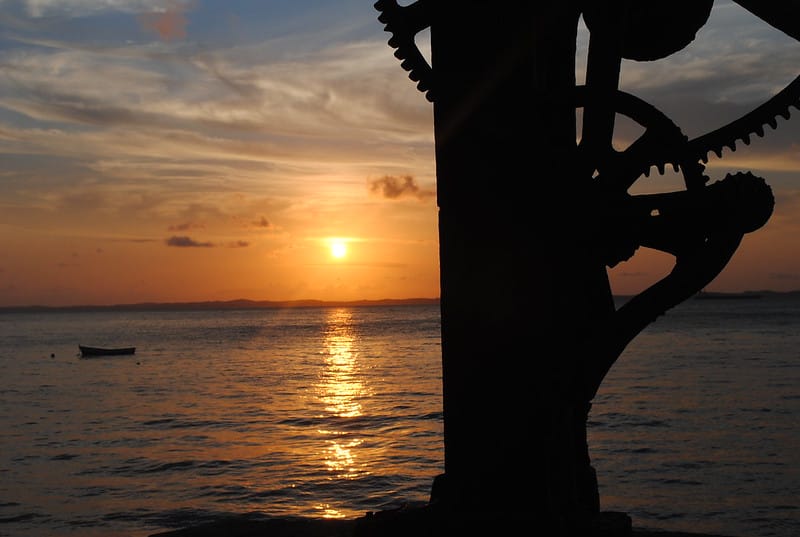
Solar do Unhão is a colonial-era building complex right by the sea, and home to the Museu de Arte Moderna da Bahia (MAM). The museum focuses on modern and contemporary Brazilian art, with temporary exhibitions, installations, and events.
Entry is usually free or very affordable, and the space itself is worth visiting even if you’re not into museums — the architecture, the gardens, and the location all make the experience interesting.
If you go in the late afternoon, stay for the sunset. The view of the Baía de Todos os Santos from the pier is one of the best in the city.
On some weekends, the museum also hosts live jazz concerts or open-air events, making it an even better place to spend the evening.
19. Immerse Yourself in Salvador’s Afro-Brazilian Culture
Salvador is the heart of Afro-Brazilian culture in Brazil. From religion and music to food and everyday customs, the African influence is present in nearly every part of life in the city.
To go beyond surface-level sightseeing, I recommend dedicating part of your trip to learning about this heritage.
You can start with a visit to Pelourinho, where you’ll find the Church of Nossa Senhora do Rosário dos Pretos, built by and for enslaved people in the 18th century, and where Catholic and Candomblé symbols blend in a powerful way.
Other important stops include the MUNCAB – National Museum of Afro-Brazilian Culture, the Casa do Benin, and the Ilê Aiyê Cultural Center in the neighborhood of Curuzu, which is known for its Afro-Brazilian pride and history.
Two additional experiences I recommend:
- Visit the Dique do Tororó, a lake near Arena Fonte Nova surrounded by sculptures of orixás (Afro-Brazilian deities). It’s an open-air tribute to Candomblé and a peaceful spot for a walk or photos.
- Visit a Candomblé terreiro (temple). This isn’t something you’ll find in guidebooks, but some terreiros open their doors for visitors who want to learn about the religion respectfully. If this interests you, try booking with a local guide who can facilitate the visit with the proper context.
If you want to understand this side of Salvador more deeply, I highly recommend booking the Afro-Brazilian Roots Private City Tour. It’s a guided experience that focuses specifically on Afro-descendant history and cultural expression, with visits to symbolic places and context you might miss otherwise.
Conclusion: Best Things to Do in Salvador Brazil
You don’t need to do everything at once — just choose what matches your style and rhythm. Salvador has something to offer every kind of traveler.



